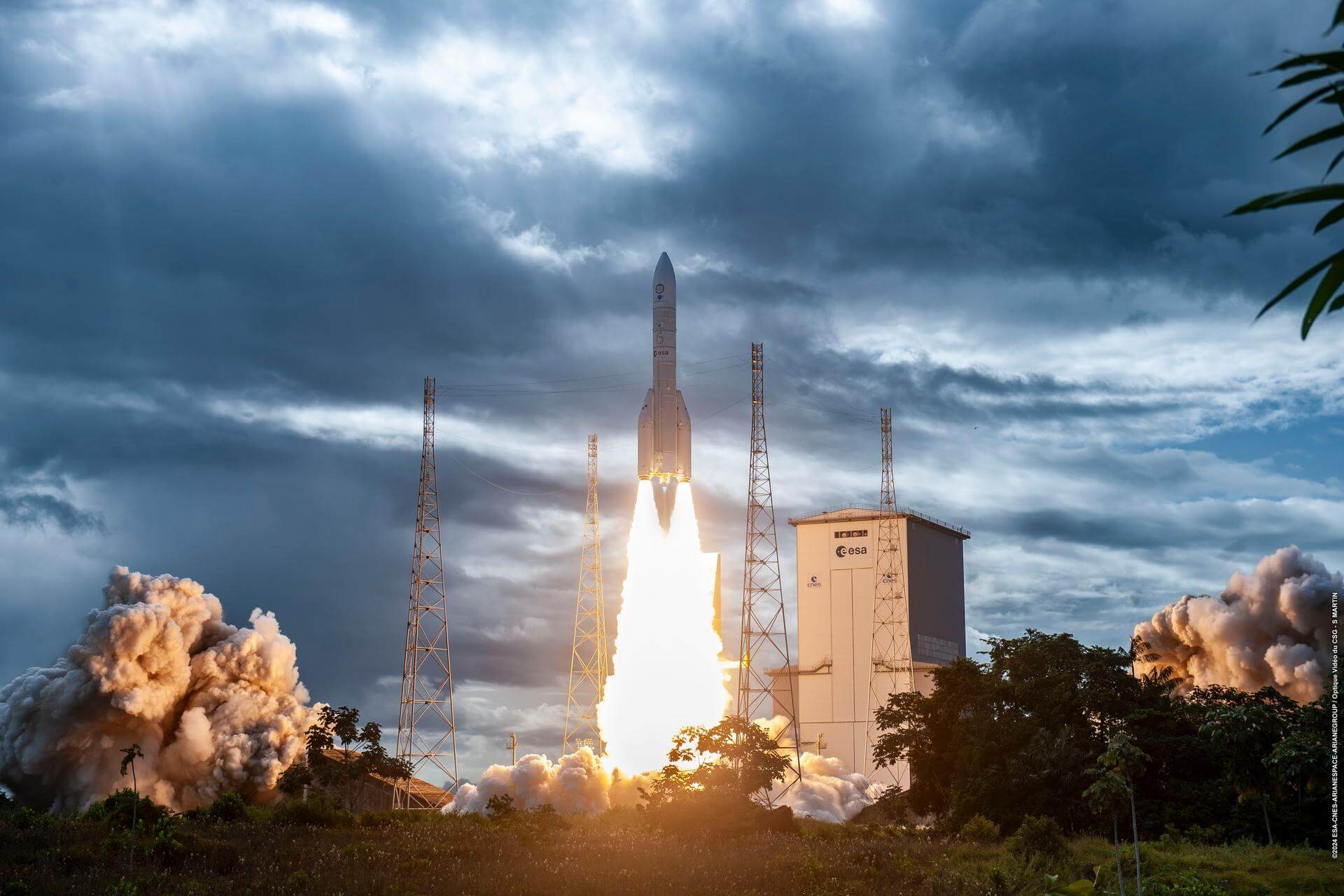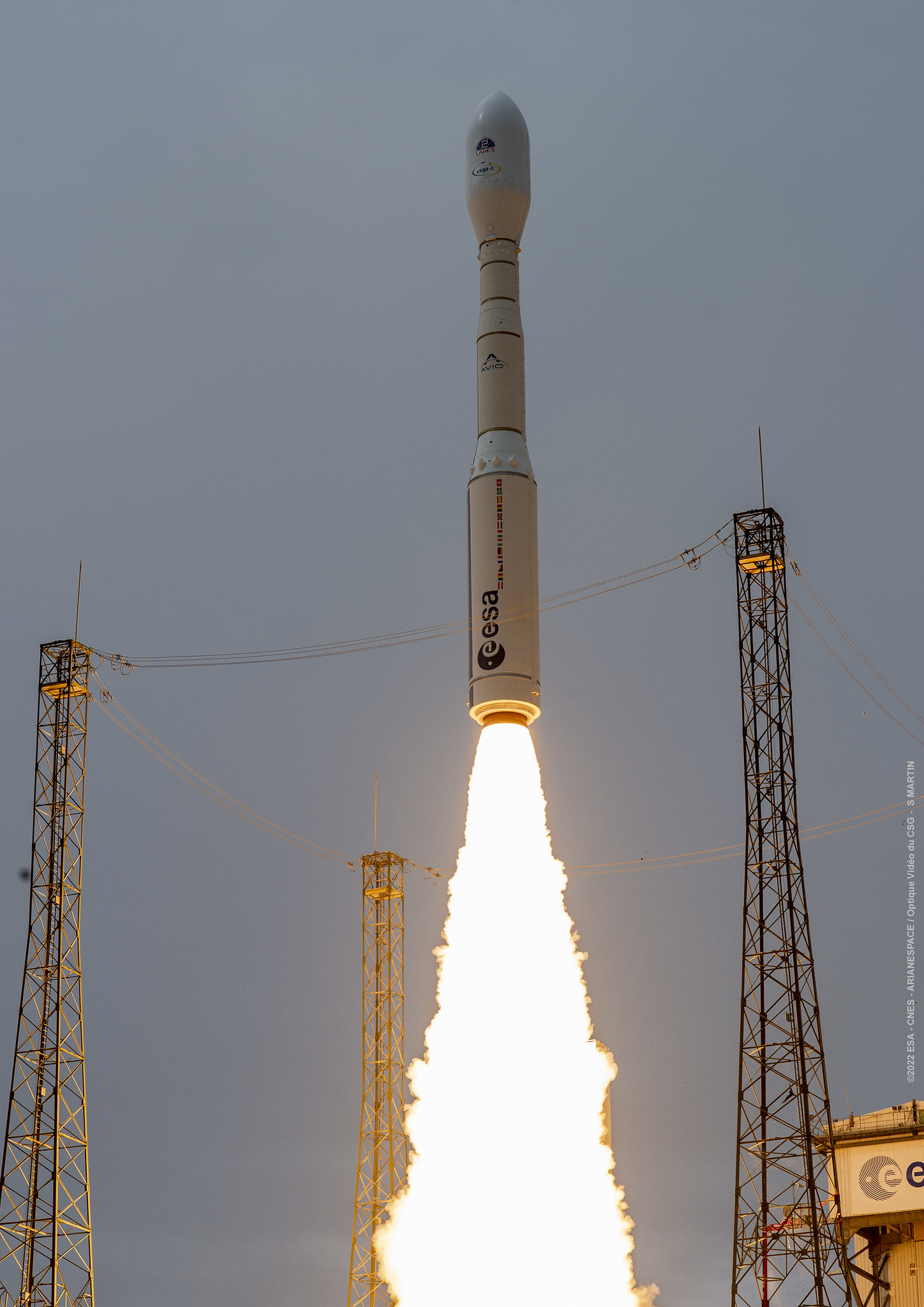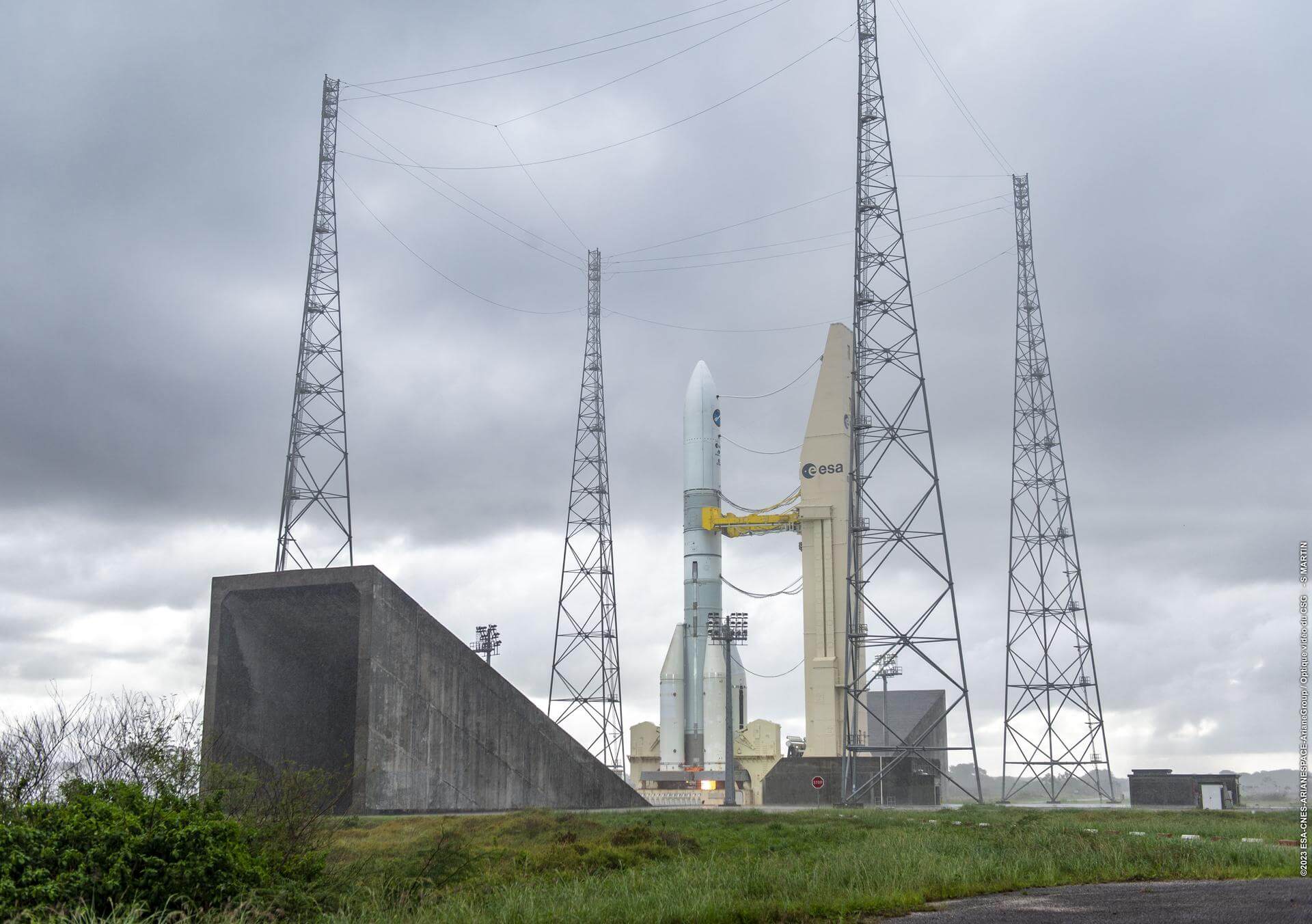Upcoming Launches
Launches that are scheduled to occur in the future

Ariane 62 | Metop-SG A1
August 13, 2025 at 0:37 UTC
Ariane Launch Area 4, Guiana Space Centre, French Guiana
Earth Science
First of EUMETSAT's second generation of Metop weather satellites.

Ariane 62 | Sentinel-1D
November 29, 2025 at 0:00 UTC
Ariane Launch Area 4, Guiana Space Centre, French Guiana
Earth Science
Sentinel-1D carries an advanced radar technology to provide an all-weather, day-and-night supply of imagery of Earth’s surface as part of the Sentinel-1 constellation.

Vega-C | Korean Multi-purpose Satellite 6 (KOMPSAT-6)
December 31, 2025 at 0:00 UTC
Ariane Launch Area 1 (ELV), Guiana Space Centre, French Guiana
Earth Science
Sixth South Korean Earth observation satellite of the KOMPSAT series. It is equipped with a synthetic aperture radar with a ground resolution between 0.5 and 20 meters.

Vega-C | PLATiNO 1
December 31, 2025 at 0:00 UTC
Ariane Launch Area 1 (ELV), Guiana Space Centre, French Guiana
Mission details are not available at this time.

Vega-C | CSG-3
December 31, 2025 at 0:00 UTC
Ariane Launch Area 1 (ELV), Guiana Space Centre, French Guiana
Earth Science
CSG-3 is an Earth observation satellite for the Italian Space Agency, part of a reconnaissance constellation using synthetic aperture radars operating in the X-band.

Miura 5 | Maiden Flight
December 31, 2025 at 0:00 UTC
Diamant Launch Area, Guiana Space Centre, French Guiana
Test Flight
First flight of the Miura 5 launch vehicle.

Ariane 64 | Project Kuiper (Ariane 6 #1)
December 31, 2025 at 0:00 UTC
Ariane Launch Area 4, Guiana Space Centre, French Guiana
Communications
Project Kuiper is a mega constellation of satellites in Low Earth Orbit that will offer broadband internet access, this constellation will be managed by Kuiper Systems LLC, a subsidiary of Amazon. This constellation is planned to be composed of 3,276 satellites. The satellites are projected to be placed in 98 orbital planes in three orbital layers, one at 590 km, 610 km and 630 km altitude. 35-40 satellites will be carried on each Ariane 6 launch.

Vega-C | IRIDE 1
December 31, 2025 at 0:00 UTC
Ariane Launch Area 1 (ELV), Guiana Space Centre, French Guiana
Earth Science
First dedicated launch for the European Space Agency's IRIDE Earth observation constellation.

Vega-C | PLATiNO 2
December 31, 2025 at 0:00 UTC
Ariane Launch Area 1 (ELV), Guiana Space Centre, French Guiana
Mission details are not available at this time.

Ariane 64 | ViaSat-3 Asia-Pacific
December 31, 2025 at 0:00 UTC
Ariane Launch Area 4, Guiana Space Centre, French Guiana
Communications
The ViaSat-3 is a series of three Ka-band satellites is expected to provide vastly superior capabilities in terms of service speed and flexibility for a satellite platform. Each ViaSat-3 class satellite is expected to deliver more than 1-Terabit per second of network capacity, and to leverage high levels of flexibility to dynamically direct capacity to where customers are located.

Ariane 62 | Galileo L14 (FOC FM29 & FM30)
December 31, 2025 at 0:00 UTC
Ariane Launch Area 4, Guiana Space Centre, French Guiana
Navigation
Payload consists of two satellites for Europe's Galileo navigation system.

Vega-C | IRIDE 2
December 31, 2025 at 0:00 UTC
Ariane Launch Area 1 (ELV), Guiana Space Centre, French Guiana
Earth Science
Second dedicated launch for the European Space Agency's IRIDE Earth observation constellation.

Vega-C | KOMPSAT-7
January 31, 2026 at 0:00 UTC
Ariane Launch Area 1 (ELV), Guiana Space Centre, French Guiana
Earth Science
KOMPSAT-7 is the follow-up model of KOMPSAT-3A whose mission is to provide high-resolution satellite images to satisfy South-Korea’s governmental and institutional needs.

Vega-C | Solar wind Magnetosphere Ionosphere Link Explorer (SMILE)
March 31, 2026 at 0:00 UTC
Ariane Launch Area 1 (ELV), Guiana Space Centre, French Guiana
Astrophysics
Joint mission between the European Space Agency and the Chinese Academy of Sciences to investigate the interaction between Earth’s protective shield – the magnetosphere – and the supersonic solar wind.

Ariane 64 | IS-45
June 30, 2026 at 0:00 UTC
Ariane Launch Area 4, Guiana Space Centre, French Guiana
Communications
Intelsat 45 is a small geostationary communications satellite that will provide Ku-band fixed-satellite services enabling Intelsat to provide specialized and efficient service to Media and Network customers. IS-45 weighs about 1 metric ton at launch and is designed and built by SWISSto12, based on the company’s innovative HummingSat platform. HummingSats are just over one cubic meter in volume, one-tenth the size of conventional satellites placed in geostationary orbit. SWISSto12 is developing the satellites in collaboration with the European Space Agency (ESA) through its public-private-partnership program, benefiting from unique and patented 3D printing technologies.

Ariane 62 | Metop-SG B1
June 30, 2026 at 0:00 UTC
Ariane Launch Area 4, Guiana Space Centre, French Guiana
Earth Science
Second of EUMETSAT's second generation of Metop weather satellites.

Ariane 64 | MTG-I2
September 30, 2026 at 0:00 UTC
Ariane Launch Area 4, Guiana Space Centre, French Guiana
Earth Science
Third of EUMETSAT's third generation of weather satellite.

Ariane 64 | Optus-11
December 31, 2026 at 0:00 UTC
Ariane Launch Area 4, Guiana Space Centre, French Guiana
Communications
Optus-11 is a Ku-band communications satellite with a coverage zone encompassing Australia and New Zealand. Optus-11 incorporates a number of advanced technologies, especially the latest developments in digital processing, plus active antennas enabling the creation of several thousand beams.

Ariane 64 | IS-41 & IS-44
December 31, 2026 at 0:00 UTC
Ariane Launch Area 4, Guiana Space Centre, French Guiana
Communications
Two geostationary communications satellites built by Thales Alenia Space for Intelsat.

Vega-C | Altius
December 31, 2026 at 0:00 UTC
Ariane Launch Area 1 (ELV), Guiana Space Centre, French Guiana
Earth Science
ALTIUS is a satellite mission proposed by the Belgian Institute for Space Aeronomy to monitor the distribution and evolution of stratospheric ozone in the Earth's atmosphere.

Ariane 64 Block 2 | Project Kuiper (Ariane 6 #3)
December 31, 2026 at 0:00 UTC
Ariane Launch Area 4, Guiana Space Centre, French Guiana
Communications
Project Kuiper is a mega constellation of satellites in Low Earth Orbit that will offer broadband internet access, this constellation will be managed by Kuiper Systems LLC, a subsidiary of Amazon. This constellation is planned to be composed of 3,276 satellites. The satellites are projected to be placed in 98 orbital planes in three orbital layers, one at 590 km, 610 km and 630 km altitude. 35-40 satellites will be carried on each Ariane 6 launch.

Vega-C | ClearSpace-1
December 31, 2026 at 0:00 UTC
Ariane Launch Area 1 (ELV), Guiana Space Centre, French Guiana
Technology
First debris removal mission by the Swiss startup ClearSpace. Contracted by the European Space Agency, it is designed to catch and de-orbit part of a Vega rocket from Low Earth Orbit using four articulated arms.

Vega-C | FLEX
December 31, 2026 at 0:00 UTC
Ariane Launch Area 1 (ELV), Guiana Space Centre, French Guiana
Earth Science
The Fluorescence Explorer (FLEX) satellite is a part of ESA's Earth Explorer program. The satellite will map vegetation fluorescence to quantify photosynthetic activity.

Vega-C | Sentinel CO2M-A
December 31, 2026 at 0:00 UTC
Ariane Launch Area 1 (ELV), Guiana Space Centre, French Guiana
Earth Science
Sentinel CO2M-A carries a near-infrared and shortwave-infrared spectrometer to measure atmospheric carbon dioxide produced by human activity, providing the EU with a unique and independent source of information, to assess the effectiveness of policy measures, and to track their impact towards decarbonizing Europe and meeting national emission reduction targets.

Vega-C | CSG-4
December 31, 2026 at 0:00 UTC
Ariane Launch Area 1 (ELV), Guiana Space Centre, French Guiana
Earth Science
CSG-4 is an Earth observation satellite for the Italian Space Agency, part of a reconnaissance constellation using synthetic aperture radars operating in the X-band.

Vega-C | Sentinel-3C
December 31, 2026 at 0:00 UTC
Ariane Launch Area 1 (ELV), Guiana Space Centre, French Guiana
Earth Science
Sentinel-3C is the third satellite in the Sentinel-3 constellation, which provides high-accuracy optical, radar and altimetry data for marine and land services.

Vega-C | EAGLE-1
December 31, 2026 at 0:00 UTC
Ariane Launch Area 1 (ELV), Guiana Space Centre, French Guiana
Technology
SES satellite to support the end-to-end secure Quantum Key Distribution (QKD) system for Europe.

Ariane 62 | Galileo L16 (FOC FM33 & FM34)
December 31, 2026 at 0:00 UTC
Ariane Launch Area 4, Guiana Space Centre, French Guiana
Navigation
Payload consists of two satellites for Europe's Galileo navigation system.

Ariane 62 | Galileo L15 (FOC FM28 & FM31)
December 31, 2026 at 0:00 UTC
Ariane Launch Area 4, Guiana Space Centre, French Guiana
Navigation
Payload consists of two satellites for Europe's Galileo navigation system.

Ariane 64 | GO-1
December 31, 2026 at 0:00 UTC
Ariane Launch Area 4, Guiana Space Centre, French Guiana
Mission details are not available at this time.

Ariane 64 | Project Kuiper (Ariane 6 #2)
December 31, 2026 at 0:00 UTC
Ariane Launch Area 4, Guiana Space Centre, French Guiana
Communications
Project Kuiper is a mega constellation of satellites in Low Earth Orbit that will offer broadband internet access, this constellation will be managed by Kuiper Systems LLC, a subsidiary of Amazon. This constellation is planned to be composed of 3,276 satellites. The satellites are projected to be placed in 98 orbital planes in three orbital layers, one at 590 km, 610 km and 630 km altitude. 35-40 satellites will be carried on each Ariane 6 launch.

Ariane 62 | PLATO
December 31, 2026 at 0:00 UTC
Ariane Launch Area 4, Guiana Space Centre, French Guiana
Astrophysics
Plato, for PLAnetary Transits and Oscillations of stars, is a European Space Agency (ESA) mission with 26 cameras to study terrestrial exoplanets in orbits up to the habitable zone of Sun-like stars. Its goal is to measure the sizes of exoplanets and discover exomoons and rings around them, as well as characterise planets' host stars by studying tiny light variations in the starlight it receives.

Vega-C | Sentinel CO2M-B
December 31, 2027 at 0:00 UTC
Ariane Launch Area 1 (ELV), Guiana Space Centre, French Guiana
Earth Science
Sentinel CO2M-B carries a near-infrared and shortwave-infrared spectrometer to measure atmospheric carbon dioxide produced by human activity, providing the EU with a unique and independent source of information, to assess the effectiveness of policy measures, and to track their impact towards decarbonizing Europe and meeting national emission reduction targets.

Vega-C | FORUM
December 31, 2027 at 0:00 UTC
Ariane Launch Area 1 (ELV), Guiana Space Centre, French Guiana
Earth Science
FORUM (Far-infrared Outgoing Radiation Understanding and Monitoring) is a satellite from the European Space Agency designed to provide insight into Earth's radiation budget using a Fourier transform spectrometer.

Vega-C | Space Rider
December 31, 2027 at 0:00 UTC
Ariane Launch Area 1 (ELV), Guiana Space Centre, French Guiana
Technology
Maiden flight of the European Space Rider (Space Reusable Integrated Demonstrator for Europe Return).

Ariane 64 | Hellas Sat 5
December 31, 2027 at 0:00 UTC
Ariane Launch Area 4, Guiana Space Centre, French Guiana
Communications
Greek geostationary communications satellite

Vega-C | Sentinel-3D
November 30, 2028 at 0:00 UTC
Ariane Launch Area 1 (ELV), Guiana Space Centre, French Guiana
Earth Science
Sentinel-3D is the fourth satellite in the Sentinel-3 constellation, which provides high-accuracy optical, radar and altimetry data for marine and land services.

Ariane 6 | 2 x Galileo Second Generation (G2)
December 31, 2029 at 0:00 UTC
Ariane Launch Area 4, Guiana Space Centre, French Guiana
Navigation
Payload consists of two satellites for Europe's second generation Galileo navigation system.

Vega-C | Harmony
December 31, 2029 at 0:00 UTC
Ariane Launch Area 1 (ELV), Guiana Space Centre, French Guiana
Earth Science
Harmony, ESA's 10th Earth Explorer mission, consists of 2 satellites that will orbit Earth in tandem with a Copernicus Sentinel-1 satellite in various configurations. The Harmony satellites’ synthetic aperture radar instruments will receive the Sentinel-1 satellite's radar signals that bounce back, or ‘backscatter’, from Earth’s surface. At the same time, Harmony’s thermal-infrared instruments provide complementary observations of the sea surface as well as the position and motion of clouds above it.

Vega-C | SBG-TIR
December 31, 2029 at 0:00 UTC
Ariane Launch Area 1 (ELV), Guiana Space Centre, French Guiana
Earth Science
The Surface Biology and Geology - Thermal Infrared (SBG-TIR) Earth Observation mission aims to provide radiometric and multispectral measurements of terrestrial and aquatic emissions for climate, ecological, and geological analyses, and to support practical applications such as food security and water management. The thermal infrared (TIR) radiometer is provided by NASA, while the VIS-NIR camera is provided by ASI. Their combination ensures high-quality observations, enabling the investigation of terrestrial and marine ecosystems, monitoring of water resources, and phenomena related to high temperatures such as wildfires and volcanic eruptions.